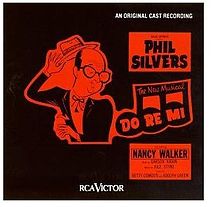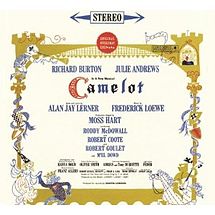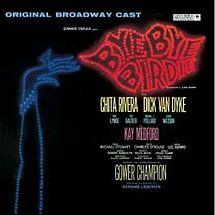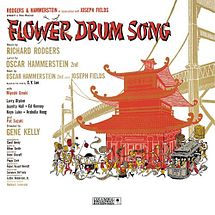
From Broadway To 52nd Street
Do-Re-Mi opened at the St. James on December 26, 1960 and starred Phil Silvers, Nancy Walker and John Reardon. Jule Styne, Betty Comden and Adolph Green composed the music and lyrics for the musical that ran 400 performances and gave the world the jazz standard Make Someone Happy.
The Story: A raucous satire on the music industry – with emphasis on the jukebox industry. Hubie Cram, a would-be big shot, induces three retired slot machine mobsters to muscle in on the jukebox racket. Though this does not make him the fawned upon tycoon he has always dreamed of becoming, Hubie does succeed in turning a waitress into a singing star.
Broadway History: The history of Black theater dates back to the turn of the century between 1890 and 1910 when the Black musical comedy was booming with the development of the Black musical theater. In 1903 composer Bert Williams and George Walker wrote “In Dahomey” and is considered the first all Black show on Broadway. The show returned a 400% profit to producers shattering the myth that Black shows were unprofitable. This was followed by a string of shows such as Shuffle Along, Showboat, How Come, The Chocolate Dandies, Africana and Keep Shufflin’. The rise of Black actors would make prominent stars of Ethel Waters, Pearl Bailey, Leslie Uggams, Bill Robinson, Josephine Baker, John Bubbles, Diahann Carroll, Ruby Dee and Sammy Davis Jr.
Over the following decades such shows as Porgy and Bess would come to Broadway along with Purlie, Raisin, Ain’t Misbehavin’, Golden Boy, Dreamgirls that would ultimately culminate in the establishment of the August Wilson Theatre, continuing the legacy of nearly a century of Black theater and inclusion in the Broadway lexicon.
Sponsored By
www.whatissuitetabu.com

From Broadway To 52nd Street
Camelot opened at the Majestic theatre on December 3, 1960 and ran for 873 performances that starred Richard Burton, Julie Andrews, Robert Goulet and Roddy McDowell. Alan Jay Lerner and Frederick Loewe composed the music that gave the world the jazz standard If Ever I Would Leave You.
The Story: The legend of King Arthur has been retold several times and it follows the exploits of his rise to power and his bringing his country under one monarch, falling in love with Guinevere and making her his queen, the illicit affair with Lancelot and the plot of Arthur’s destruction by his bastard son, to the fall of Camelot is set to music in this enjoyable portrayal of royal English life.
Jazz History: In the 1960s Afro-Cuban jazz grew as an extension of the movement that began in the 50s after bebop musicians such as Dizzy Gillespie and Billy Taylor started bands influenced Xavier Cugat, Tito Puente and Arturo Sandoval. The natural progression to Latin jazz combined the rhythms from Africa and Latin American countries that incorporated various instruments as conga, timbale, guiro and claves with jazz and classical harmonies. Though Afro-Cuban was after the bebop period, Brazilian jazz became extremely popular in the Sixties pioneered by Joao Gilberto, and Antonio Carlos Jobim. The rhythms of bossa nova, which were derived from samba, were first adapted to jazz by Charlie Byrd and Stan Getz.
Sponsored By
www.whatissuitetabu.com

From Broadway To 52nd Street
Bye-Bye Birdie opened at the Martin Beck Theatre on April 14, 1960 with Lee Adams and Charles Strouse composing the music. Running 607 performances the musical starred Dick Van Dyke, Chita Rivera, Dick Gautier, Kay Medford, Susan Watson and Paul Lynde. Two actors, Van Dyke and Lynde would go on to star in the film version. A Lot Of Livin’ To Do and Put On A Happy Face are two compositions that would go on to become jazz standards.
The Story: A popular rock star, Conrad Birdie, is about to be drafted and his agent, Albert, arranges a coup he hopes will keep revenues coming in during Conrad’s stint and allow him to marry Rosie. They pick a girl in a small American town to represent girls across the country to be sung to one last time before Conrad enters the service. Albert’s mother is against the marriage and breaks it up. Conrad goes off to have a wild night, Albert wins back Rosie but everything is turned upside down in the small town.
Broadway History: An Off-Off-Broadway production that features members of Actors Equity is called an Equity Showcase production, however, not all Off-Off-Broadway shows are Equity Showcases. The union maintains very strict rules about working in such productions, including restrictions on price, the length of the run and rehearsal times. Professional actors’ participation in showcase productions is frequent and comprises the bulk of stage work for the majority of New York actors. There has been an ongoing movement to revise the Equity Showcase rules, which many in the community find overly restrictive and detrimental to the creation of New York theatre.
The term indie theatre, or independent theatre, coined by playwright Kirk Bromley, has been adopted by many as a replacement for the term Off-Off-Broadway, and is used by groups such as The League of Independent Theater and the website nytheatre.com.
Sponsored By
www.whatissuitetabu.com

From Broadway To 52nd Street
Flower Drum Song opens the curtains of the St. James Theatre on December 1, 1958 and runs for 600 performances. The music composed by Richard Rodgers and Oscar Hammerstein for actors Pat Suzuki, Juanita Hall, Miyoshi Umeki, Larry Blyden, Jack Soo, Arabella Hong, Ed Kenney and Keye Luke leave the world with the jazz classic Love, Look Away.
The Story: Wang Chi-yang, a wealthy 63-year-old man Chinese refugee lives in San Francisco’s Chinatown with his two sons. He has a cough, which symbolizes his authority and his resistance to American culture and refusal to adopt Western ways. He is also at odds with his sister-in-law and his sons who are assimilating. Older son Wang Ta woos nightclub dancer Linda, but discovering she has many men dumps her. Linda’s seamstress friend Helen cannot find a man and gets Ta drunk, seduces him, has a short-lived affair. Ta eventually abandons her and then she commits suicide.
Impatient at Ta’s inability to find a wife, Wang arranges a marriage for his son. However, before she arrives, Ta meets a young woman, May Li, and with his father’s approval he and May Li fall in love. He vows to marry her after she is falsely accused of stealing a clock. Wang struggles to understand the conflicts that have torn his household apart; his hostility toward assimilation is isolating him from his family. In the end Wang decides to go to a Chinese-run Western clinic, symbolizing that he is beginning to accept American culture.
Jazz History: Hard bop, an extension of bebop or “bop” music that incorporates influences from rhythm and blues, gospel and blues especially in the saxophone and piano playing. Hard bop was developed in the mid-1950s, partly in response to the vogue for cool jazz in the early 1950s. The hard bop style coalesced in 1953 and 1954, paralleling the rise of rhythm and blues. Miles Davis’ performance of “Walkin” the title track of his album of the same year, at the very first Newport Jazz Festival in 1954, announced the style to the jazz world. The quintet Art Blakey and the Jazz Messengers fronted by Blakey featured pianist Horace Silver and trumpeter Clifford Brown, who were leaders in the hard bop movement along with Davis.
Sponsored By
www.whatissuitetabu.com

From Broadway To 52nd Street
West Side Story opened at the Winter Garden Theatre on September 26, 1957. Stephen Sondheim and Leonard Bernstein composed and wrote the score for the musical that ran 732 performances. Larry Kert, Carol Lawrence, Chita Rivera, Mickey Cain and Ken Leroy were the stars of the show that gave the jazz world such classics as Somewhere, I Feel Pretty, Tonight, Maria and Cool.
The Story: On the streets of West Side Manhattan in the late summer of 1957, there is mounting racial tension between rival white American and Puerto Rican gangs to maintain control of the neighborhood – the Jets and the Sharks. An interracial relationship blossoms between Tony and Maria who see past their ethnic differences. However, Maria’s brother Bernardo and leader of the Sharks does not want this love-match to succeed. Destined to be short-lived, a rumble between the two gangs ensues, Maria begs Tony to stop it, the fight escalates from lists to knives and Tony ultimately kills Bernardo.
When Bernardo’s girlfriend Anita learns of his death she is overcome with emotion and seeking out Maria, who already knows, discovers Tony is with her. Tony leaves for refuge at Doc’s drugstore after which they learn that Chino was seeking revenge for Bernardo by shooting Tony. Maria begs Anita to go tell Tony but after a mock rape at the hands of the Jets, Anita delivers a different message – that Maria is dead. In shock Tony runs out screaming for Chino to come kill him. On the playground Tony and Maria see each other but before they can embrace Chino shoots and kills Tony.
Broadway History: The Off-Off-Broadway movement began in 1958 as a reaction to Off-Broadway, and a “complete rejection of commercial theatre”.[2] Among the first venues for what would soon be called “Off-Off-Broadway” were coffeehouses in Greenwich Village, particularly the Caffe Cino at 31 Cornelia Street, operated by the eccentric Joe Cino, who early on took a liking to actors and playwrights and agreed to let them stage plays there without bothering to read the plays first, or to even find out much about the content. Also integral to the rise of Off-Off-Broadway were Ella Stewart at La MaMa and Al Carmines at the Judson Poets’ Theater, located at Judson Memorial Church, Playbox Studio, New York Theatre Ensemble, The Old Reliable, The Dove Company and the Nuyorican Poets Cafe.
Sponsored By
www.whatissuitetabu.com


